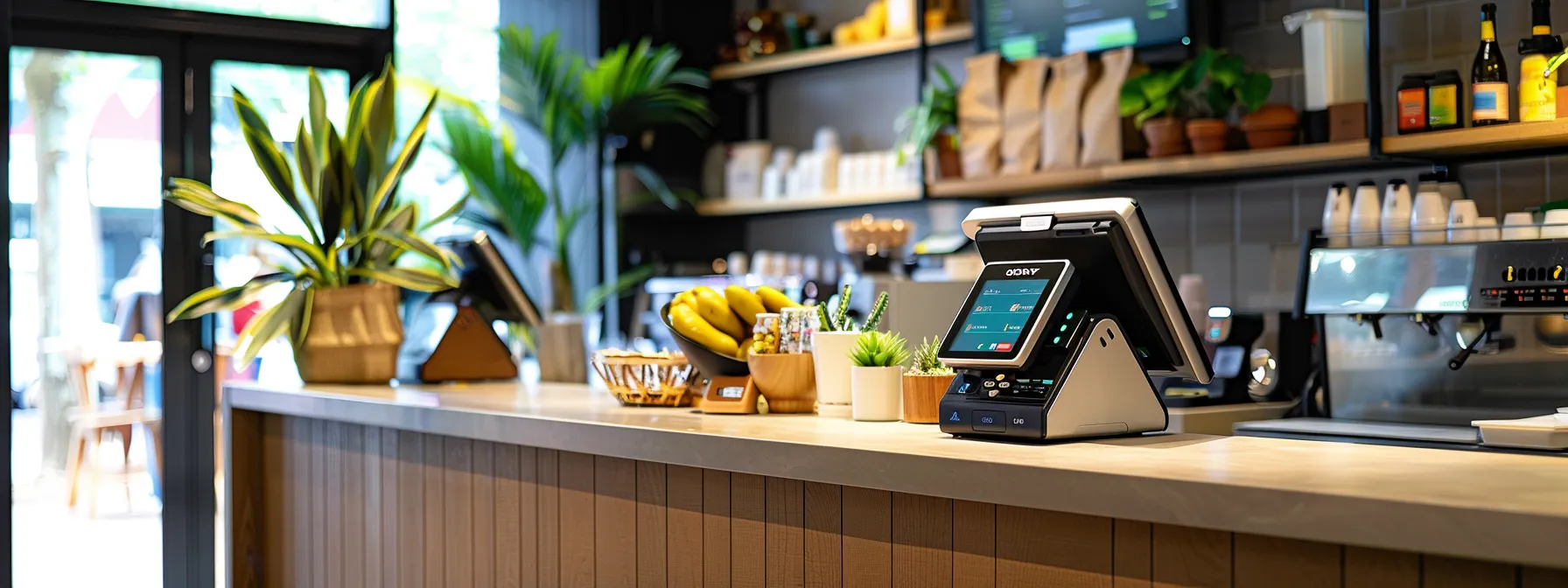Are you ready to take your small business into the future of shopping with cashless commerce? This transformative approach is swiftly taking the commercial world by storm. Our focused content will guide you through the key insights of this shift, including understanding cashless systems, reaping the benefits, and navigating the challenges. By adopting technologies that support cash-free transactions, you’ll streamline management and automation, tightening up data security in the process. We’ll also provide actionable steps for a smooth transition. Dive in to learn how preparing for cashless operations now can safeguard your business for tomorrow’s market.
Key Takeaways
- Small businesses benefit from cashless commerce through improved inventory and cash flow management
- Digital payment options enhance security and meet consumer expectations for convenience
- Training staff in cashless transactions is key to providing a smooth customer experience
- Staying abreast of payment technology trends is crucial for business competitiveness
- Customer feedback on cashless systems informs continual improvement and service refinement
Understanding Cashless Commerce for Small Businesses

Small businesses are rapidly joining the shift to cashless commerce, transforming how they interact with customers. The move towards electronic payments not only changes the consumer shopping experience but also offers a wealth of benefits, enhancing cloud computing capabilities, productivity, and customer relationship management. This section delves into the impact of adopting cashless solutions and examines the various payment methods transforming the retail landscape. The focus will be on how these technologies can become valuable assets for small businesses, integrating with enterprise resource planning for streamlined operations.
Discover the Impact of Cashless Commerce on Retail
As small businesses embrace cashless commerce, they witness notable changes in how inventory management and cash flow are handled. Cashless transactions provide real-time data, helping companies understand their stock levels and best sellers, which optimises their market offerings. Additionally, since physical money handling and related expenses decrease, there’s a boost in overall financial efficiency. This shift not only makes operations smoother but also delivers a more streamlined shopping experience for customers.
By moving away from cash, a corporation can significantly reduce the risks and costs associated with theft and fraud. More importantly, cashless methods match today’s consumer expectations for quick and seamless transactions. For many businesses, the transition to electronic payments is not just about adhering to a trend but staying competitive within their market. Adopting cashless systems, therefore, becomes a strategic decision to enhance operations and customer satisfaction:
| Aspect | Impact on Retail |
|---|---|
| Inventory | Optimisation through real-time tracking |
| Cash Flow | Improved by reduced physical handling and expenses |
| Consumer Experience | Enhanced by quick and efficient transactions |
| Security | Strengthened by reducing theft and fraud risks |
| Market Competition | Stay relevant by meeting consumer expectations |
Identify Key Cashless Payment Methods Available
In the realm of cashless commerce, small businesses are presented with a suite of payment options, each designed to streamline financial transactions with efficiency. Among the most favoured methods are contactless cards and mobile payments, which not only quicken the checkout process but also sync effortlessly with accounting software. This eases the workload for the company‘s accountants, freeing them from time-consuming cash counts and allowing a sharper focus on strategic financial planning.
Moreover, the rise of virtual wallets and online payment systems has revolutionised trade for small enterprises, connecting them seamlessly with a global customer base. Transactions via these platforms are instant and secure, often incurring lower processing fees than traditional banking services. By integrating such innovative payment solutions, a company ensures its adaptability in a fast-paced market, providing convenience both to the business and its clientele—one email confirmation at a time.
Embracing Benefits of a Cashless Business Model

Transitioning to cashless commerce opens new horizons for small businesses, presenting opportunities to boost sales and tighten security. By incorporating digital payment options, companies witness an uptick in transactional efficiency, often leading to increased revenue. Simultaneously, sophisticated accounting software supports secure finance management, lowering theft risks—a particular advantage for sole proprietorships attentive to cost control. These pivotal changes underpin the vitality of moving away from traditional cash-based systems.
Increase Sales With Digital Payment Options
By integrating digital payment options, small businesses are not only meeting current market trends but are also priming themselves for an uptick in sales. This cashless shift allows for the trimming of overhead costs associated with cash management, such as licence fees for cash-handling equipment and the labour associated with bookkeeping. When customers have the ease of paying with a tap or click, the speedier transaction process can lead to a higher volume of sales, underscoring the positive correlation between convenience and purchasing frequency.
Research supports the claim that offering a variety of payment options can substantially elevate a small business’s appeal, especially to tech-savvy consumers who prefer cashless and mobile banking methods. Furthermore, with every digital transaction, a footprint is created, streamlining tax reporting and reducing the margin for error in financial records. In turn, this detailed recording of transactions aids companies in refining their sales strategies and forecasting future trends, providing a solid foundation for sustained business growth.
Improve Security and Reduce Theft Risks
When a small business switches to cashless systems, it strikes at the heart of security concerns, severely reducing the chances of theft. The absence of cash on the premises acts as a deterrent to petty crimes, thus safeguarding the brand‘s assets and reputation. This layer of protection is critical not just for physical premises but also in fortifying digital transactions against fraud, contributing to a robust marketing strategy that promotes safety as a key brand value.
Moreover, adopting a cashless model can streamline content marketing efforts, as it gears towards a target audience that values tech-powered convenience and security. By integrating cashless payments, a company can glean insights through data analytics from each transaction, enabling a more precise email marketing approach. This strategic move subtly heightens trust amongst clientele, as they appreciate the enhanced security measures protecting their personal and financial information.
Addressing Challenges in Going Cashless

Transitioning to cashless commerce is not without its challenges for small businesses. Entrepreneurs must carefully navigate customer hesitance and ensure they adhere to strict data protection laws to safeguard their clients’ information. This section will explore practical strategies to boost acceptance among a target market that may be resistant to card payments, while also highlighting the importance of protecting intellectual property in a cash-free environment. Failing to address these issues can increase risks and diminish the effectiveness of advertising efforts in promoting a cashless approach.
Overcome Customer Resistance to Card Payments
Winning over customers who are wary of card payments starts by emphasising the security and convenience of not needing to carry cash. Small businesses can build trust by clarifying how card transactions can offer additional protection against unauthorised charges, giving patrons peace of mind that their bank account is safer. Additionally, explaining the rewards such as cashback or credit points often associated with card payments can shift perspectives, showing that embracing modern payment methods adds value beyond the transaction itself.
Moreover, for small enterprises looking to break down resistance, offering flexible payment solutions can be key. This might involve providing zero-interest payment plans for high-value purchases, which can feel more manageable for customers and potentially increase their willingness to invest. These options require substantial capital management on the business‘s part, yet can position the company as a forward-thinking outfit that prioritizes customer needs, ultimately leading to broader acceptance of cashless commerce.
Ensure Compliance With Data Protection Laws
For small businesses, the leap into cashless commerce brings with it the responsibility of complying with data protection laws, ensuring that customer credit card details, along with employment and insurance information, are secure. This means investing in robust point-of-sale systems that encrypt sensitive data, and understanding the regulations that govern digital payments. As a result, many small businesses might find it prudent to seek advice or broader services, such as a business loan, to cover the costs of upgrading their security measures, ensuring compliance and peace of mind for both them and their customers.
| Challenge | Response |
|---|---|
| Data protection compliance | Upgrade point-of-sale systems with encryption |
| Financing security upgrades | Potential business loans to cover costs |
It’s critical that, in the shift to cashless operations, small enterprises must not overlook the training of their teams on data protection best practices. Regular updates on the latest threats and the importance of maintaining rigorous controls are as vital as the software they employ. Through this education, businesses can guard against breaches, which have the potential to damage reputation and financial stability. After all, knowledge and preparation are the cornerstones of effective cybersecurity.
Steps to Transition Your Business to Cashless

Moving to cashless commerce requires a well-orchestrated approach, especially for small businesses looking to stay ahead. One must choose the right cashless payment solutions, tapping into partnerships that offer state-of-the-art digital wallets and seamless payment system integration. The key is to embed these technologies within existing POS systems, ensuring transactions are effortless both in-store and via any mobile app. This transition not only aligns with evolving online advertising trends but also positions businesses to meet customer expectations in a digitised market.
Select Suitable Cashless Payment Solutions
For small businesses aiming to thrive in a cashless society, selecting the right payment solutions is essential. Mobile payment platforms and contactless payment methods like NFC-enabled debit cards are fast becoming the norm, making financial transactions swift and secure. These tools not only align with customer expectations but also pave the way for businesses to streamline their operations, bolstering their move to a cashless model.
When choosing payment solutions, a business needs to consider the needs of its customer base alongside the functionality offered. Integrating systems that support a wide range of payment options can mitigate the unease some customers may feel toward going cashless. Offering these diverse, yet user-friendly ways to pay, such as contactless or mobile payment options, can help strengthen the relationship a business has with its clients, ensuring they feel catered to and confident in every transaction.
Integrate Digital Payments Into POS Systems
Integrating digital payments into existing point-of-sale (POS) systems is a crucial step for small businesses making the switch to cashless. By updating their payment terminals to accommodate card payments and mobile payment methods, businesses ensure money transactions are swift and secure. This modernisation allows for automatic invoice generation, which greatly simplifies the reconciliation process, saving invaluable time for both the merchant and their customer.
Another significant move is linking the POS system with an Automated Clearing House (ACH) and a reliable payment processor. This setup streamlines the flow of funds and ensures that transactions are processed accurately and efficiently. When the payment terminal is equipped with such sophisticated backend support, businesses are aptly geared to handle higher volumes of transactions, bolstering their capability to meet customer demand in a dynamic cashless marketplace.
Training Staff for Cashless Operations Success

To secure a spot in the evolving commercial community, small businesses must pivot strategically towards cashless operations. This crucial step forward entails upskilling employees in the use of advanced payment devices and cultivating protocols that assure frictionless transactions. Emphasizing both employee education and the development of transaction protocols, small businesses like limited liability companies can leverage payment gateways and card technologies to stay grounded in an increasingly digital marketplace.
Educate Employees on Using Payment Devices
As small businesses in Australia adapt their business model to incorporate cashless systems, educating employees on the use of payment devices becomes critical. Staff members need to be confident in operating the latest payment technologies, ensuring they can assist consumers swiftly and effectively. This comfort with technology also means they can interpret payment analytics, providing the business with valuable insights into customer behaviour and spending patterns.
Hands-on training with project management software is also beneficial, equipping teams with the skills to efficiently track and manage payment devices and related transactional data. By understanding the nuts and bolts of cashless transactions, employees can contribute to a smoother consumer experience and uphold the integrity of the business‘s cashless model. This proactive approach not only prepares staff for inevitable technological progress but also primes the business for success in a competitive market.
Develop Protocols for Smooth Transactions
For small businesses, the incorporation of innovation in payment processes is not simply a matter of technology design, it’s about crafting protocols that safeguard revenue and enhance customer satisfaction. By training staff on the exact procedures for processing digital payments, companies can prevent mishaps that might strain the budget or compromise data security. This investment in educating team members often pays off in smooth, error-free transactions that bolster consumer trust.
Building protocols around new payment technology starts with the computer at the heart of a business‘s operations. Staff must be adept at using this technology, from the point-of-sale system to the backend accounting software, to ensure every transaction contributes positively to revenue growth. It’s also about having a clear action plan for when things don’t go as intended; being prepared to troubleshoot effectively can make all the difference to a customer‘s experience:
- Train employees thoroughly on all aspects of cashless transaction management.
- Establish a quick and effective resolution process for payment issues.
- Regularly review and update protocols to reflect the latest technological advancements.
Keeping Up With Future Cashless Payment Trends

As the digital marketplace evolves, small businesses must stay current with cashless payment trends to maintain robust customer experiences. Adopting mobile and contactless payment technologies minimises liability and keeps companies abreast with internet-driven consumer trends. With a digital wallet just a tap away, understanding and integrating customer preferences protects business interests and nurtures lasting relationships. The sections that follow will unpack the significance of these advancements in detail.
Adopt Mobile and Contactless Payment Technologies
Small businesses looking to remain at the forefront of retail must adopt mobile and contactless payment technologies to stay competitive. With buyers increasingly relying on smartphones for transactions, integrating near-field communication (NFC) for tap-to-pay features or even allowing payment via cryptocurrency can set a shop apart. This tech-savvy approach not only aligns with search engine trends, favouring businesses that are up to date but also meets the growing expectations of a convenience-driven consumer base.
Utilising artificial intelligence within payment systems can further refine customer service, as it helps personalise shopping experiences and streamline the checkout process. For instance, a small business specialising in drop shipping may enhance its operational efficiency by employing AI-driven tools that verify transactions and anticipate fraud. These advancements in payment technology not only secure the business‘s revenue stream but also build trust with customers who appreciate the blend of innovation and security.
Stay Informed on Evolving Customer Preferences
Staying on top of customer preferences is essential for small businesses adapting to cashless commerce. As the daily use of mobile phones for payments becomes more prevalent, customers are continually looking for a frictionless experience. Integration of seamless technologies like QR code-based transactions allows businesses to respond to this trend, offering both convenience and a modern touch at the checkout point.
Gathering feedback is another key element in understanding and evolving with customer preferences. Small businesses can leverage interaction points, such as post-purchase surveys sent to a customer’s mobile phone, to evaluate the ease of their cashless systems. This feedback loop not only captures sentiments around the cashless transition but also identifies areas of depreciation in the customer experience, guiding continual improvement:
| Customer Interaction Point | Purpose |
|---|---|
| QR code Payments | Offer streamlined, contactless payment options |
| Feedback Surveys | Identify customer pain points and areas for enhancement |
| Post-Purchase Engagement | Measure satisfaction and inform service adjustments |
Conclusion

The journey to cashless commerce is a strategic upgrade that requires a blend of information technology and new skill sets. As small businesses adopt these changes, they open doors to enhance their operations and customer interactions. Investing in training or hiring skilled freelancers can ensure that transitions in payment systems occur smoothly, without hiccups.
It’s clear that the adoption of cashless systems can be a powerful move in managing business debt, streamlining payments, and improving cash flow. By reducing the physical handling of cash, small businesses can lower their risk exposure and optimize their financial operations, indirectly impacting their equity positively as a result of lower overhead costs.
Small businesses today are not just changing how they handle transactions, but also how they view the intersection of commerce and technology. Leveraging cashless commerce, companies are gaining more control over their financial health, becoming more agile and better positioned to adapt to future market shifts.
In conclusion, the shift towards cashless commerce is not just about staying current with market trends, but about embracing the opportunities that modern information technology offers. As small businesses equip themselves with the necessary skills, embrace the support of freelancers, and navigate the shift from debt to equity, they set themselves up for success in a rapidly evolving retail landscape.
Frequently Asked Questions
What exactly does cashless commerce entail for a small business?
Cashless commerce means small businesses can offer faster transactions, improved customer experience, and streamlined payment processing, all leading to increased efficiency.
How can a cashless system benefit my small enterprise?
A cashless system enhances efficiency, improves transaction speed, and reduces handling costs, providing a secure, streamlined experience for both small businesses and their customers.
What challenges might I face when moving to cashless transactions?
Shifting to cashless payments can present issues such as security concerns, technical glitches, and potential overspending due to less tangible tracking of funds.
What steps should I take to make my business cashless?
To transition your business to a cashless operation, select a reliable digital payment system, educate your staff on electronic transactions, update your payment policies, and inform your customers about the new payment methods available.
How do I train my staff effectively for cashless operations?
To train staff effectively for cashless operations, ensure they’re well-versed with digital payment systems and provide hands-on practice sessions for a smooth transition.
Conclusion
Adopting cashless commerce equips small businesses with the tools to increase sales and improve security, positioning them well in a tech-driven market. By selecting suitable cashless payment solutions and integrating them into their operations, these businesses meet customer demands for convenience and speed. Training staff to manage new payment systems and developing protocols ensure transactions are secure and efficient. Ultimately, the transition to cashless transactions is a strategic move that enhances operation efficiency, and financial health, and positions small businesses for future market developments.


